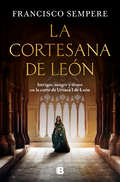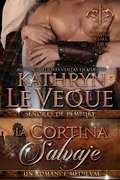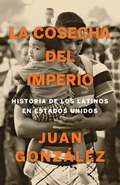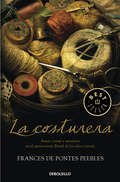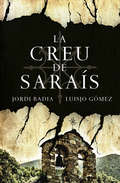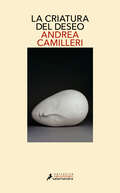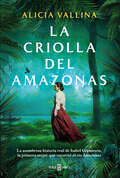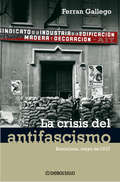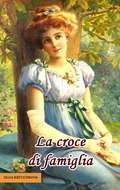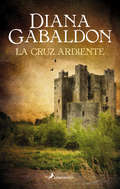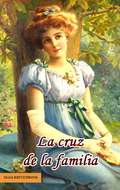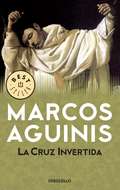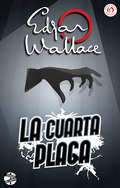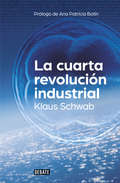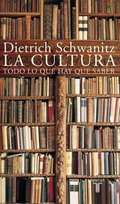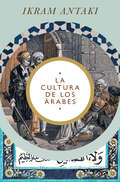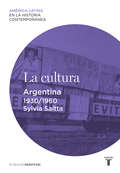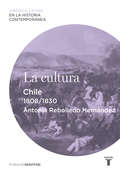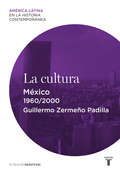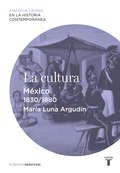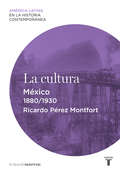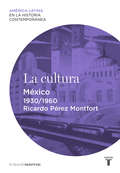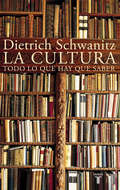- Table View
- List View
La cortesana de León
by Francisco SempereUna vida de lucha por el trono. Una batalla de reyes en la que se alzará una reina. 1100 d. C. La turbulenta línea de sucesión de los reinos de León, Castilla y Galicia obliga a doña Urraca de Zamora, hermana y mano derecha del rey Alfonso VI, a asegurar un futuro para su sobrina, la infanta Urraca, a la que el monarca ha apartado del trono en favor de su hijo menor, Sancho Alfónsez.Sin embargo, la consejera real no está dispuesta a permitirlo y por ello decide encargar a Lisarda, una joven y astuta cortesana con pocos medios, intrigar en la corte con el objetivo de que su protegida sea coronada como reina de pleno derecho en contra de la voluntad del soberano. El cometido de Lisarda no es fácil, pero con la ayuda del mercenario Petro el Cartaginés, pronto comenzará a urdir una estratagema para que reyes, nobles y demás señores de la corte caigan en sus redes. En la estela de Aquitania o La cocinera de Castamar, Francisco Sempere nos adentra en los entresijos de lacorte de León y nos cuenta la historia de Urraca I la Temeraria en una novela llena de aventuras, intrigas, deseo y luchas de poder.
La cortina Salvaje
by Kathryn Le Veque Paula A. Silva FauréLa cortina salvaje por Kathryn Le Veque ¿Podrá su amor de Señora salvar a un caballero de la espada de su ejecuto? 1333 D.C. – Al final de la victoria Inglesa de la Colina de Halidon, el Rey Edward coloca a Stephen of Pembury como el Guardián Protector de la recientemente capturada ciudad de Berwick. Para consolidar esa victoria, él ordena a Stephen casarse con la hija del comandante derrotad, la Señora Joselyn de Velt Seton. En un matrimonio que pretende simbolizar la dominación Inglesa sobre los Escoceses, Stephen sin embargo se siente atraído por su nueva novia; una pequeña, belleza de pelo negro con ojos azul pálido. Joselyn es un Señora con un horrible pasado y oscuros secretos de abuso. Ella se resiste al matrimonio al principio pero eventualmente su atracción por Stephen prueba ser mucho para resistir y el par se enamoran profundamente. Pero aun cuando su amor florece, Escoceses insurgentes contra atacan Berwick y Stephen es tomado prisionero. Como Guardián Protector de Berwick, él es un poderoso premio para los Escoceses y su ejecución pública ha sido ordenada. Los viejos amigos de Stephen, Tate de Lara (La Espada de Dragón) y Kenneth St. Hever (Isla de vidrio) deben conspirar para rescatar a Stephen incluso con Joselyn e inesperados aliados lanzan su propio intento de rescate. Es una carrera contra el tiempo para salvar a Stephen de la espada ejecutora en esta historia de conquista, oscuros secretos y amor eterno.
La cosecha del imperio / Harvest of Empire: Historia de los latinos en Estados Unidos
by Juan GonzalezUna historia arrolladora, cuidadosamente revisada y actualizada, de la experiencia latina en Estados Unidos. Es la primera reedición en diez años de este importante estudio sobre los latinos en la historia de Estados Unidos. La cosecha del imperio cubre un periodo de cinco siglos, desde las primeras colonias en el Nuevo Mundo, hasta la primera década del nuevo milenio. Hoy en día, los latinos representan el grupo minoritario más grande en Estados Unidos, y su impacto en la cultura popular del país —desde la comida, hasta el entretenimiento y la literatura— es más profundo que nunca. Con retratos de familia de pioneros latinos migrantes, así como recuentos de los eventos y condiciones que los llevaron a dejar sus patrias, La cosecha del imperio es una lectura obligada para cualquiera que desee comprender la historia y el legado de este grupo, cuya influencia va en aumento. Juan González, columnista del New York Daily News, ha vivido en Estados Unidos cincuenta de sus cincuenta y un años. Sus numerosos reconocimientos incluyen el Premio George Polk en 1998 por la excelencia en el periodismo, y el premio a su trayectoria de parte de la Academia Hispánica de Artes Mediáticas y Ciencias. Nacido en Puerto Rico, creció en un barrio de multifamiliares y fue cofundador del partido Young Lords en los años sesenta. Vive en la Ciudad de Nueva York.
La costurera
by Frances De Pontes PeeblesUna saga familiar ambientada en el Brasil colonial de los años treinta. La historia de dos hermanas huérfanas que deberán convivir con un trasfondo de inestabilidad política y de desastres naturales. Emília y Luzia dos Santos, dos hermanas con una excelente destreza para la costura, sueñan con escapar de su pequeño pueblo, un anhelo que separa sus vidas... Luzia sufre una deformidad desde que un accidente en la infancia la dejara lisiada y se convierte en una muchacha ruda y también poco casadera. Su única oportunidad de conseguir la independencia y la felicidad será casarse con el bandido que la secuestra, Antonio, el Halcón. En cambio Emília es delicada como una flor. Quiere una vida acomodada y refinada en la ciudad, por lo que contrae matrimonio con el hijo de un rico médico, a pesar de no estar enamorada de él.Los caminos de las dos hermanas se vuelven a unir cuando la vida de una de ellas corre peligro, aunque ya no son las mismas que en el pasado: Emília se siente sola y desgraciada y Luzia se ha convertido en una forajida a la que apodan, la Costurera. Frances de Pontes Peebles nos demuestra con su novela la importancia de los lazos familiares, inquebrantables incluso en la distancia y en la adversidad. Su cuidado estilo, su sensibilidad y su facilidad para contar grandes historias de sagas familiares, le han servido además para que numerosos medios la comparen con Gabriel García Márquez e Isabel Allende. Reseñas:«Los seguidores de García Márquez devorarán esta magnífica novela.»Frau Im Leben
La creu de Saraís
by Jordi Badia Luisjo GómezMentides, traïcions i una seqüència trepidant d’esdeveniments abocaran el lector a una trama plena d’emocions, que va des de l’edat mitjana fins al segle XXI, en escenaris tan dispars com Bangkok, Lisboa, Barcelona i Butiaba (Uganda), amb la vall de Boí com a centre de gravetat i el teló de fons, carregat d’enigmes, de les pintures romàniques que en són l’emblema. Una creu ha passat desapercebuda al llarg de la història. El símbol d’una missió començada a l’edat mitjana i mantinguda en secret durant un mil·lenni: a la batalla d’Arsuí, al setge de Montsegur, a la França prerevolucionària... noms i llocs coneguts que són fites ignorades del transcurs d’aquesta missió. El sergent de policia Ramon Palau, estirant el fil d’un estrany suïcidi a Barcelona, s’enfrontarà a aquest enigma i el relacionarà amb una cadena de crims recent que gira al voltant d’un misteriós llegat que ha passat de portador en portador al llarg dels segles. I, gairebé sense adonar-se’n, la investigació i l’amor d’una dona el posaran al punt de mira dels fanàtics per qui la religió és només una carta marcada en el joc del poder.
La criatura del deseo
by Andrea CamilleriBasándose en personajes y hechos reales, Andrea Camilleri reconstruyela tormentosa relación entre Alma Mahler y Oskar Kokoschka En 1912, un año después de la muerte de Gustav Mahler, Alma, su joven viuda conoció al pintor Oskar Kokoschka. Así comienza su historia de amor, que pronto desembocará en una pasión tan desenfrenada como tumultuosa. Pero cuando Alma rompe brutalmente la relación, Kokoschka, con el corazón destrozado, decide partir al frente. A su regreso, traumatizado por el conflicto y obsesionado aún con el amor perdido, encarga una muñeca de tamaño natural con los rasgos de su amada. A partir de escritos biográficos, cartas y otros materiales inéditos, Andrea Camilleri reconstruye no solo la sobrecogedora historia de una desenfrenada pasión amorosa, en la que pugnan el genio artístico y la enfermedad mental, sino también una época crucial para el destino de Europa. La crítica ha dicho... «Por su capacidad para ahondar en un mundo que ya había visitado tanto y descubrir cosas nuevas, las novelas criminales o novelas negras de Camilleri ajenas al universo de Montalbano son su derivada más interesante.» El País«A partir de escritos biográficos, cartas y otros materiales inéditos, el siciliano ofrece una historia de pasión desenfrenada.» El Debate «Una historia asombrosa y verídica. Una crónica perversa en la que Kokoschka ejecuta con furia la matanza simbólica de una mujer rebelde. Un mundo de proyecciones y mitos. El sueño de Pigmalión. Doctor Coppelius y Coppelia, su codiciado maniquí. Los fetiches eróticos de los cuerpos hinchables.» La Repubblica
La criolla del Amazonas
by Alicia VallinaLa asombrosa historia real de Isabel Gramesón, que en el siglo XVIII se convirtió en la primera mujer en recorrer la Amazonía ecuatoriana. Cuando en 1740 se desmantela la expedición científica de la que forma parte Jean Godin des Odonnais, y que tenía como objetivo calcular la longitud del meridiano terrestre en Ecuador, Isabel Gramesón, su esposa, toma la decisión más arriesgada de su vida. Por amor, irá en busca de Jean, atravesando el río Amazonas, en una aventura jamás emprendida por una mujer. Acompañada por una comitiva de indígenas y por parte de su propia familia, Isabel vivirá una lucha por la supervivencia en un lugar hostil y prácticamente inexplorado para el hombre. ¿Conseguirá reencontrarse con su esposo? Después de Hija del mar (Plaza & Janés, 2021), que ganó el Premio de Novela Histórica Pozuelo de Alarcón, Alicia Vallina narra una trepidante novela histórica sobre una mujer que acometió una hazaña inigualable con la que demostró su amor y su espíritu de superación. "Una aventura épica a la altura de las grandes gestas históricas, protagonizada por una heroína real cuya peripecia estremece y cautiva desde la primera página". Isabel San Sebastián
La crisis del antifascismo
by Ferran GallegoLas organizaciones políticas y sociales catalanas, que habían combatido la sublevación de julio de 1936, no fueron capaces de mantener la unidad durante la Guerra Civil. Esta obra, un minucioso recorrido por aquellos trascendentes días de mayo, arranca de la unanimidad democrática del 14 de abril de 1931 para estudiar, a continuación, las razones que provocaron ese intenso conflicto. Gracias a un análisis detallado de las fuentes históricas, prensa, documentación inédita y memorias, y a un profundo rigor histórico, Ferran Gallego da cuenta de las diversas estrategias reformistas y revolucionarias de la izquierda española y estudia cómo estas divergencias se convirtieron en antagónicas de cara a la organización del antifascismo, la defensa de la democracia y el tipo de revolución que se pretendía llevar a cabo en el país. Habría de ser en Cataluña, una zona de singulares características sociales -con un republicanismo populista de masas, la potencia de la CNT, el surgimiento de un nuevo partido del Frente Popular como el PSUC y la existencia de un importante comunismo heterodoxo representado por el POUM- donde este conflicto se daría con mayor intensidad, y desembocaría en las jornadas de mayo de 1937, que permiten, por sí mismas, comprender los problemas internos de la República y la Guerra Civil.
La crisis del antifascismo: Barcelona, mayo de 1937
by Ferran GallegoEn la primera semana de mayo de 1937, Barcelona vivió un violento enfrentamiento armado entre diversos sectores republicanos. Las organizaciones políticas y sociales catalanas, que habían combatido la sublevación de julio de 1936, no fueron capaces de mantener la unidad durante la Guerra Civil. Esta obra, un minucioso recorrido por aquellos trascendentes días de mayo, arranca de la unanimidad democrática del 14 de abril de 1931 para estudiar, a continuación, las razones que provocaron ese intenso conflicto. Gracias a un análisis detallado de las fuentes históricas, prensa, documentación inédita y memorias, y a un profundo rigor histórico, Ferran Gallego da cuenta de las diversas estrategias reformistas y revolucionarias de la izquierda española y estudia cómo estas divergencias se convirtieron en antagónicas de cara a la organización del antifascismo, la defensa de la democracia y el tipo de revolución que se pretendía llevar a cabo en el país. Habría de ser en Cataluña, una zona de singulares características sociales -con un republicanismo populista de masas, la potencia de la CNT, el surgimiento de un nuevo partido del Frente Popular como el PSUC y la existencia de un importante comunismo heterodoxo representado por el POUM- donde este conflicto se daría con mayor intensidad, y desembocaría en las jornadas de mayo de 1937, que permiten, por sí mismas, comprender los problemas internos de la República y la Guerra Civil.
La croce di famiglia
by Olga KryuchkovaInnokentij Elenskij ottiene un posto da insegnante di letteratura a Mosca e si trasferisce dalla città natale alla sua nuova residenza. Dopo qualche tempo sua moglie Natalja, assieme alla piccola figlia Arina, sale su una carrozza e a sua volta parte per Mosca, al seguito del marito. Lungo la strada, però, la carrozza viene assalita dalla banda di briganti di Fischione. Natalja e i suoi compagni di viaggio vengono uccisi. Fischione prende Arina con sé per compassione, però in seguito si lega a lei come se fosse la propria figlia e riesce a sistemarsi a Mosca. Arina cresce in una situazione di benessere economico e fisico, senza sospettare che a farla crescere non è stato il suo vero padre. Con gli anni, Arina diviene una bellissima signorina. In punto di morte il «padre» confida alla ragazza che molti anni prima l’aveva raccolta lungo la strada che portava a Mosca e le consegna una croce che aveva tolto al cadavere di sua madre. Arina è sconvolta: colui che considerava essere suo padre è invece il colpevole della morte di sua madre! Non appena Arina rimane orfana, inizia ad essere corteggiata da molti cacciatori di dote. Il finto «padre», però, ha insegnato alla ragazza a badare a se stessa e a sparare bene con la pistola. Soprattutto, Arina non abbandona la speranza di incontrare il grande amore e di ritrovare il vero padre.
La cruz ardiente (Saga Outlander #Volumen 5)
by Diana GabaldonArrolladora e inolvidable, la quinta entrega de la saga «Outlander» de Diana Gabaldon es un vibrante drama humano dibujado sobre el tapiz de la Historia. Con una maestría narrativa sin igual, La cruz ardiente no defraudará a los miles de leales seguidores de la autora y asombrará a los lectores que todavía no la han descubierto. En este largamente esperado quinto volumen, Diana Gabaldon narra una historia que puede considerarse la más emocionante de la extraordinaria saga de Claire Randall, compuesta por Forastera, Atrapada en el tiempo, Viajera y Tambores de otoño. Dividida entre salvar a su marido de los peligros que se avecinan, o por el contrario contribuir a provocar el estallido de la violencia entre la Corona inglesa y las trece colonias norteamericanas, Claire vive otra vezel dilema de quien, aun conociendo los acontecimientos del futuro, tiene que adaptarse a su vida del presente. Nacida en 1918 en Inglaterra, Claire Randall sirvió como enfermera en la Segunda Guerra Mundial. Terminado el conflicto, un extraordinario viaje en el tiempo la trasladó a las Tierras Altas escocesas en 1743, y pese a haberse convertido en esposa de Jamie Fraser, y más tarde en madre y cirujana, Claire continúa sintiéndose extranjera, fuera de su lugar y de su tiempo.
La cruz de la familia
by Olga KryuchkovaInnokenti Yelenski es nombrado profesor de literatura en Moscú y se traslada de su ciudad natal a su nuevo lugar de residencia. Al cabo de un tiempo su esposa Natalia junto con su pequeña hija Arina alquila un carruaje y se dirige a Moscú en pos del marido. Sin embargo, por el camino el carruaje es atacado por la banda de Svistún. Natalia y los otros viajeros mueren. Svistún recoge a Arina por compasión. Pero se encariña con ella, como si fuera de su sangre y se instala en Moscú, donde vive con holgura. Arina crece en la abundancia, sin sospechar que quien la educa no es su verdadero padre. Con el paso de los años Arina se convierte en una señorita encantadora. En el lecho de muerte su “padre” le confiesa que muchos años atrás la había recogido en el camino que llevaba a Moscú y le entregó una crucecita que había arrancado del cadáver de su madre. Arina estaba confundida. Ése a quien consideraba su padre era ¡el culpable de la muerte de su madre! Apenas se quedó huérfana, a su alrededor empezaron a revolotear a su alrededor loa cazadores de herencias. Sin embargo, el “padre” fallecido había enseñado a la muchacha a defenderse y a disparar un arma con precisión. No obstante, Arina no perdía la esperanza de encontrar el verdadero amor y descubrir a su verdadero padre.
La cruz invertida (Premios Planeta Ser.)
by Marcos Aguinis Gustavo PerednikLa novela ganadora del Premio Planeta de España en 1970 puede considerarse un mordaz fresco de Latinoamérica. Fue calificada de "profética" por la intensidad de sus denuncias y por anticiparse a la dictadura de los setenta. La acción se desenvuelve en un país indeterminado, pero sintetiza al continente y expresa nostalgia por su unidad perdida. Aún mantiene vigencia entre cientos de miles de lectores. El hombre, contradictorio y abismal, abre su anatomía en diversos cortes. Algunos personajes asumen rasgos caricaturescos. Su presencia y pensamiento en distintos planos suelen enhebrarse mediante el leit-motiv de la epístola, cursiva, puntuación o crueldad. «La cruz invertida» provoca continuamente la reflexión. Numerosos capítulos llevan el título de los libros bíblicos en que se inspiran, integrando una cerrada unidad. Su lenguaje refleja el rostro del continente dionisíaco: luminoso, enigmático, irónico, grotesco, voluble, sádico, tierno y casi siempre simbólico. Como en la Biblia -novela del cosmos-, la totalidad pretende ser absorbida (y con ella el Bien, el Mal, el Gris), pero la frustración amputa proyectos.
La cuarta plaga
by Edgar WallaceUna sociedad secreta italiana, robos, secuestros, una plaga histórica renacida, artefactos misteriosos, extrañas coincidencias.El palacio Festini se alza, lúgubre y magnífico, en Terzo Città. Es el hogar de los Festini, que viven de pasadas grandezas y no temen despertar antiguas rivalidades que se enraizan en la Edad Media.Esta es la historia de la Mano Roja, una organización criminal a cuya cabeza está el conde Festini, tal vez el hombre más peligroso de Europa.
La cuarta revolución industrial
by Klaus Schwab¿Qué es la cuarta revolución industrial? ¿Cómo definirá nuestro futuro? Un libro sobre el cambio de paradigma que vive nuestra sociedad actual por el fundador del Foro Davos. Son muchos los desafíos a los que se enfrenta el mundo hoy en día, pero posiblemente uno de los más importantes sea comprender la nueva revolución tecnológica que está acarreando la transformación de la humanidad debido a la convergencia de sistemas digitales, físicos y biológicos. Las nuevas tecnologías están cambiando la manera en la que vivimos, trabajamos y nos relacionamos los unos con los otros y la velocidad, amplitud y profundidad de esta revolución nos están obligando a repensar cómo los países se desarrollan, cómo las organizaciones generan valor e incluso lo que significa ser humanos. En La Cuarta Revolución Industrial, Klaus Schwab, fundador del Foro Económico Mundial, describe las características clave de la nueva revolución tecnológica y resalta las oportunidades y dilemas que ésta plantea. Las nuevas formas de colaboración y gobernabilidad, acompañadas de una narrativa positiva y compartida, pueden moldear la cuarta revolución industrial para beneficio de todos. Si aceptamos la responsabilidad colectiva de crear un futuro en el que la innovación y la tecnología sirvan a las personas, podremos llevar a la humanidad a nuevos niveles de conciencia moral.
La cultura
by Dietrich SchwanitzÉste es un libro para aquellos que quieren tener una relación viva con su cultura. Muchas veces el conocimiento se ha visto encorsetado por fórmulas y barreras, y se ha alejado de su labor más útil, que es enriquecer nuestras vidas y ayudar a conocernos mejor. ¿Cómo y por qué surgieron la sociedad moderna, el Estado, la ciencia, la democracia o la administración? ¿Qué ha dicho Heidegger que no supiéramos ya? ¿Por qué Don Quijote, Hamlet, Fausto, Robinson, Falstaff o el Dr. Jekyll y Mr. Hyde son figuras tan conocidas? ¿Dónde estaba el inconsciente antes de Freud? Este libro aborda los episodios remotos y centrales del Antiguo y Nuevo Testamento; la emergencia de los Estados y la epopeya de la modernización, las revoluciones y la democracia; la evolución de la literatura, el arte y la música a través de sus grandes obras; el desarrollo de la ciencia y la filosofía, el campo de batalla de las ideologías, cosmogonías y teorías; pero también la educación que dan los libros, los colegios o universidades, los periódicos y los foros de opinión. Un cuadro cronológico, una breve relación de los libros que han cambiado el mundo y consejos de lectura aumentan la utilidad de esta obra imprescindible.
La cultura de los árabes
by Ikram AntakiCONOCE LA CULTURA DE LOS ÁRABES DE LA PLUMA DE IKRAM ANTAKI «El poeta Abul-Atahiya había grabado en el interior de su anillo: “Maldiga dios a la gente”. Y la gente que conoció eran aquellos árabes conquistadores y comerciantes que tradujeron la filosofía y la ciencia de los griegos, pero jamás dieron a conocer su propia literatura, que observaron el mundo y se olvidaron del cuerpo, que ejercieron hasta el cansancio su mente y desconocieron su alma. Quise hablar de estos árabes cuerdos y necios, derechos y torcidos, que he conocido a través de la vida compartida, de las leyes, de la literatura, del arte, de la filosofía, de la economía...
La cultura. Argentina (América Latina en la Historia Contemporánea )
by Sylvia SaíttaLa vida cultural e intelectual en Argentina desde finales del XIX hasta casi mediado el siglo XX. Un completo panorama de la vida cultural e intelectual en Argentina desde finales del XIX hasta casi mediado el siglo XX. Una visión del horizonte creativo y de las obras más representativas de este período que reflejan una modesta pero cierta modernización cultural. La colección América Latina en la Historia Contemporánea es uno de los proyectos editoriales más importantes de las últimas décadas y una aportación original y novedosa a la historiografía sobre América Latina en la que han participado más de 400 historiadores de diversos países. Presenta una visión plural y accesible de la historia contemporánea de las naciones latinoamericanas -incluyendo aquellas otras, europeas o americanas, que más han aportado a su materialización- y revela las claves políticas, sociales, económicas y culturales que han determinado su trayectoria y el lugar en el mundo que hoy ocupan. Distinciones:Premio de la revista La Aventura de la Historia a la mejor iniciativa editorial
La cultura. Argentina (América Latina en la Historia Contemporánea )
by Sylvia SaíttaUna amplia visión de la vida cultural e intelectual en Argentina ya mediado el siglo XX. Un completo panorama de la vida cultural e intelectual en Argentina ya mediado el siglo XX. Una visión del horizonte creativo y de las obras más representativas de este período marcado por una crisis política que acabará dañando también al ámbito cultural. La colección América Latina en la Historia Contemporánea es uno de los proyectos editoriales más importantes de las últimas décadas y una aportación original y novedosa a la historiografía sobre América Latina en la que han participado más de 400 historiadores de diversos países. Presenta una visión plural y accesible de la historia contemporánea de las naciones latinoamericanas -incluyendo aquellas otras, europeas o americanas, que más han aportado a su materialización- y revela las claves políticas, sociales, económicas y culturales que han determinado su trayectoria y el lugaren el mundo que hoy ocupan. Distinciones:Premio de la revista La Aventura de la Historia a la mejor iniciativa editorial
La cultura. Chile (América Latina en la Historia Contemporánea )
by Antonia Rebolledo HernándezUn amplio recorrido sobre la vida cultural e intelectual en Chile. Un completo panorama de la vida cultural e intelectual en Chile bajo el impacto de la Ilustración y las repercusiones de la extensión de la imprenta con la consiguiente difusión de la lectura. Dos circunstancias que incidirán en el sistema educativo, las letras, las bellas artes, la moda, etc. La colección América Latina en la Historia Contemporánea es uno de los proyectos editoriales más importantes de las últimas décadas y una aportación original y novedosa a la historiografía sobre América Latina en la que han participado más de 400 historiadores de diversos países. Presenta una visión plural y accesible de la historia contemporánea de las naciones latinoamericanas -incluyendo aquellas otras, europeas o americanas, que más han aportado a su materialización- y revela las claves políticas, sociales, económicas y culturales que han determinado su trayectoria y el lugar en el mundo que hoy ocupan. Distinciones:Premio de la revista La Aventura de la Historia a la mejor iniciativa editorial
La cultura. México (América Latina en la Historia Contemporánea )
by Guillermo Zermeño PadillaUn completo panorama de la vida cultural e intelectual en México en el que se repasan no sólo la parte artística de la cultura en este período, sino también la moda y los gustos, expresiones plásticas y literarias, la educación y los planes de estudios, el ocio, las manifestaciones públicas, etc. La colección América Latina en la Historia Contemporánea es uno de los proyectos editoriales más importantes de las últimas décadas y una aportación original y novedosa a la historiografía sobre América Latina en la que han participado más de 400 historiadores de diversos países. Presenta una visión plural y accesible de la historia contemporánea de las naciones latinoamericanas -incluyendo aquellas otras, europeas o americanas, que más han aportado a su materialización- y revela las claves políticas, sociales, económicas y culturales que han determinado su trayectoria y el lugar en el mundo que hoy ocupan. Distinciones:Premio de la revista La Aventura de la Historia a la mejor iniciativa editorial
La cultura. México (América Latina en la Historia Contemporánea )
by María Luna ArgudínUna extensa visión de la vida cultural e intelectual en México desde comienzos hasta casi mediado el siglo XIX. Un completo panorama de la vida cultural e intelectual en México desde comienzos hasta casi mediado el siglo XIX. Una visión del horizonte creativo y de las obras más representativas de este período, así como de los aspectos esenciales en la actividad cultural y artística del país, que giraron en torno a dos preocupaciones: la libertad individual y la identidad. La colección América Latina en la Historia Contemporánea es uno de los proyectos editoriales más importantes de las últimas décadas y una aportación original y novedosa a la historiografía sobre América Latina en la que han participado más de 400 historiadores de diversos países. Presenta una visión plural y accesible de la historia contemporánea de las naciones latinoamericanas -incluyendo aquellas otras, europeas o americanas, que más han aportado a su materialización- y revela las claves políticas, sociales, económicas y culturales que han determinado su trayectoria y el lugar en el mundo que hoy ocupan. Distinciones:Premio de la revista La Aventura de la Historia a la mejor iniciativa editorial
La cultura. México (América Latina en la Historia Contemporánea )
by Ricardo Pérez MontfortLa vida cultural e intelectual en México desde los inicios del porfiriato hasta los años posrevolucionarios. Un completo panorama de la vida cultural e intelectual en México desde los inicios del porfiriato hasta los años posrevolucionarios. Una visión del horizonte creativo y de las obras más representativas de este período, así como de los aspectos esenciales en la actividad cultural y artística del país, que con la Revolución darían un vuelco radical. La colección América Latina en la Historia Contemporánea es uno de los proyectos editoriales más importantes de las últimas décadas y una aportación original y novedosa a la historiografía sobre América Latina en la que han participado más de 400 historiadores de diversos países. Presenta una visión plural y accesible de la historia contemporánea de las naciones latinoamericanas -incluyendo aquellas otras, europeas o americanas, que más han aportado a su materialización- y revela las claves políticas, sociales, económicas y culturales que han determinado su trayectoria y el lugar en el mundo que hoy ocupan. Distinciones:Premio de la revista La Aventura de la Historia a la mejor iniciativa editorial.
La cultura. México (América Latina en la Historia Contemporánea )
by Ricardo Pérez MontfortUna amplia visión de la vida cultural e intelectual en México entre 1930 y 1960. Un completo panorama de la vida cultural e intelectual en México en el que se repasan los procesos de institucionalización de la cultura mexicana entre 1930 y 1960, cuando se produce el tránsito de una reivindicación de la cultura popular a una cultura promovida por el Estado. La colección América Latina en la Historia Contemporánea es uno de los proyectos editoriales más importantes de las últimas décadas y una aportación original y novedosa a la historiografía sobre América Latina en la que han participado más de 400 historiadores de diversos países. Presenta una visión plural y accesible de la historia contemporánea de las naciones latinoamericanas -incluyendo aquellas otras, europeas o americanas, que más han aportado a su materialización- y revela las claves políticas, sociales, económicas y culturales que han determinado su trayectoria y el lugar en el mundo que hoy ocupan. Distinciones:Premio de la revista La Aventura de la Historia a la mejor iniciativa editorial
La cultura: Todo lo que hay que saber (Ensayo (punto De Lectura) Ser.)
by Dietrich SchwanitzLa gran biblia cultural. Ésta es una obra para aquellos que quieren tener una relación viva con el saber, sin fórmulas ni barreras. Para los que piensan que la labor más útil de la cultura es enriquecer nuestras vidas y ayudar a conocernos mejor. <P><P>Éste es un libro para aquéllos que quieren tener una relación viva con su cultura. Muchas veces el conocimiento se ha visto encorsetado por fórmulas y barreras, y se ha alejado de su labor más útil, que es enriquecer nuestras vidas y ayudar a conocernos mejor. <P>¿Cómo y por qué surgieron la sociedad moderna, el Estado, la ciencia, la democracia o la administración? ¿Qué ha dicho Heidegger que no supiéramos ya? ¿Por qué Don Quijote, Hamlet, Fausto, Robinson, Falstaff o el Dr. Jekyll y Mr. Hyde son figuras tan conocidas? ¿Dónde estaba el inconsciente antes de Freud? <P>Este libro aborda los episodios remotos y centrales del Antiguo y Nuevo Testamento; la emergencia de los Estados y la epopeya de la modernización, las revoluciones y la democracia; la evolución de la literatura, el arte y la música a través de sus grandes obras; el desarrollo de la ciencia y la filosofía, el campo de batalla de las ideologías, cosmogonías y teorías; pero también la educación que dan los libros, los colegios o universidades, los periódicos y los foros de opinión. Este libro, además, contiene una tabla cronológica, una breve relación de los libros que han cambiado el mundo, consejos de lectura y un índice onomástico muy detallado que aumentan la utilidad de esta obra imprescindible.
